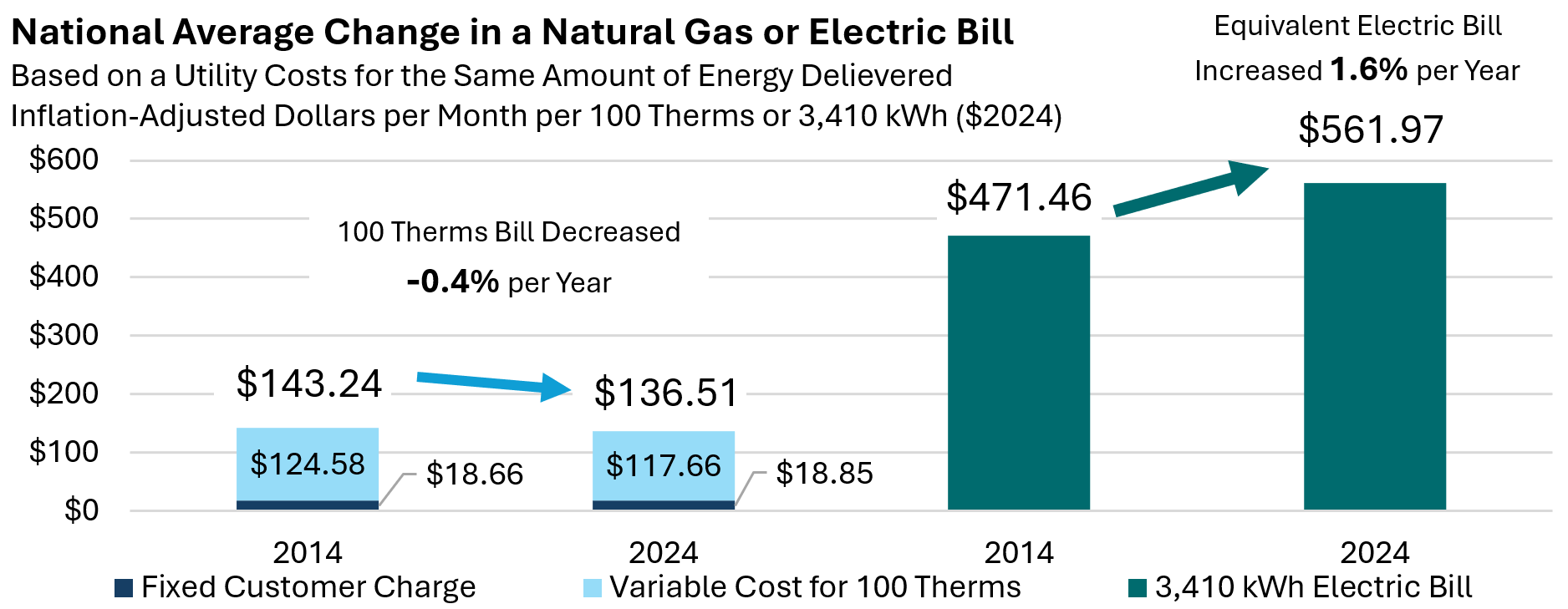Affordable Natural Gas Service Supported by Fixed Customer Charges

Natural gas utilities tend to use fixed charges in the customer bill to recover fixed costs to deliver gas, and variable charges to recover variable costs. Those costs may include the cost of maintaining safe and reliable service. Utility bills generally include charges for energy distribution, energy supply, fixed monthly customer charges, and taxes. A significant portion of utility costs can be considered fixed over the period a given rate is in effect.
In recent years, on average, gas bills have shifted towards a larger fixed component charge that benefits both customers and utilities. While some worry this could lead to higher bills, the data show the opposite: as the fixed charge component of gas bills has increased, gas bills have remained the same in inflation-adjusted terms, which contrasts with rising electric bills.
Key Findings
- Fixed customer charges provide predictable cost recovery for essential gas infrastructure without inflating customer bills and thereby encouraging more energy efficiency and decarbonization measures.
- Since 2014, 100-therms adjusted residential natural gas bills have decreased from $143 to $136 per month, or -0.4% per year. The inflation-adjusted fixed customer charge for residential customers has, on average, increased from $18.66 to $18.85 since 2014, or 0.1% per year. The relative stability of fixed customer charges over this period is principally due to inflation and maintaining the natural gas system.
- Average electric bills normalized to a 3,410-kWh (100 therms equivalent) rate of consumption and adjusted for inflation have grown from $471 per month to $562, an increase of 1.6% per year.
- In East North Central, where the average fixed charges surveyed increased the most from an adjusted $19 to $24 or 1.8% per year, final energy bills for consumers have decreased from an adjusted $121 to $99 at an annual rate of -1.8%.

AGA Contact: Brendan O’Brien, 202-824-7220.
Notice
In issuing and making this publication available, AGA is not undertaking to render professional or other services for or on behalf of any person or entity. Nor is AGA undertaking to perform any duty owed by any person or entity to someone else. Anyone using this document should rely on his or her own independent judgment or, as appropriate, seek the advice of a competent professional in determining the exercise of reasonable care in any given circumstances. The statements in this publication are for general information and represent an unaudited compilation of statistical information that could contain coding or processing errors. AGA makes no warranties, express or implied, nor representations about the accuracy of the information in the publication or its appropriateness for any given purpose or situation. This publication shall not be construed as including advice, guidance, or recommendations to take, or not to take, regarding any matter, including without limitation relating to investments or the purchase or sale of any securities, shares or other assets of any kind. Should you take any such action or decision; you do so at your own risk. Information on the topics covered by this publication may be available from other sources, which the user may wish to consult for additional views or information not covered by this publication.
Copyright © 2025 American Gas Association. All rights reserved.